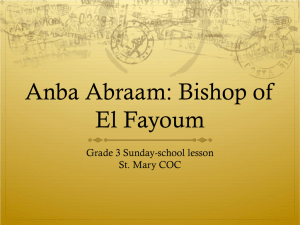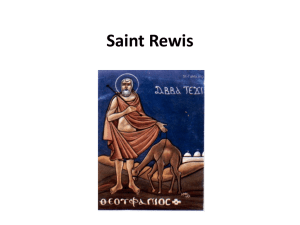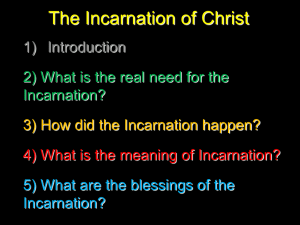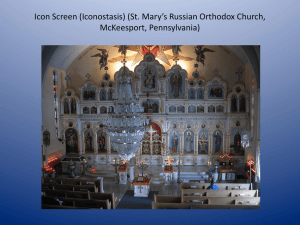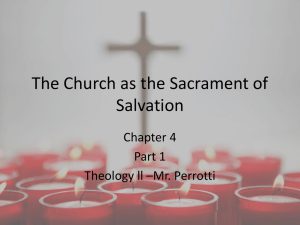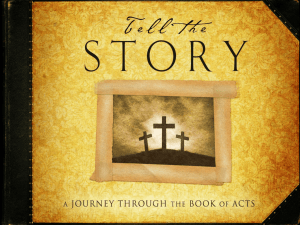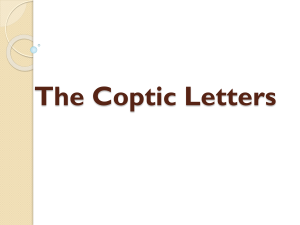Ihab Ghoubrial Copto-Arabic Tradition of Theosis
advertisement
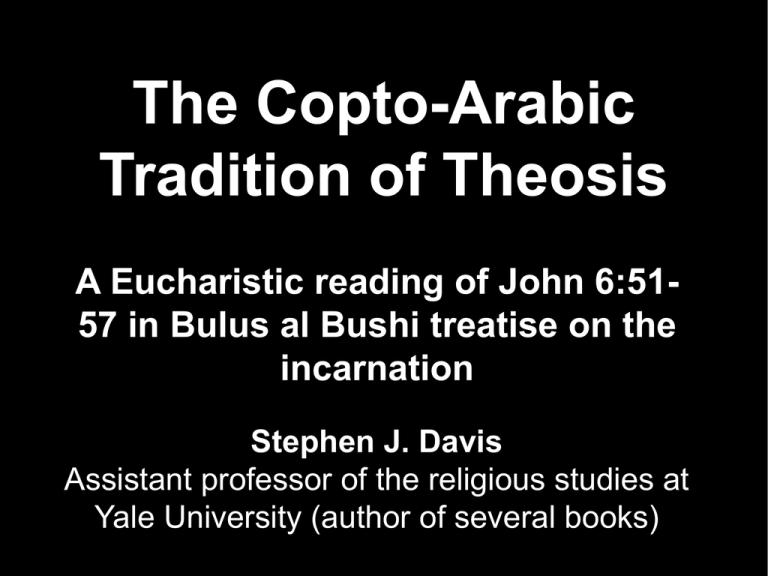
The Copto-Arabic Tradition of Theosis A Eucharistic reading of John 6:5157 in Bulus al Bushi treatise on the incarnation Stephen J. Davis Assistant professor of the religious studies at Yale University (author of several books) الكنيسة القبطية االرثوذكسية Anba Bulus al Bushi االنبا بولس البوشي • (أبونا اندراوس االريزونيAnouna Andraus El Arizoni) • 1170-1250 • In the Ayyubid rule rule of Egypt • Was a monk. • Served as bishop of Old Cairo Wrote many biblical commentaries , books and homilies on the life of Christ corresponding to to eight major feasts in the Coptic calendar • The Coptic feasts are (feasts of the Lord, feasts of St. Mary and the Saints) • Eight major feast of the Lord (feasts related directly to our salvation), and eight minor feasts of the Lord. The Lord’s Feasts of Salvation • The Annunciation • The Nativity • The Epiphany • Palm Sunday • Easter • Ascension • Pentecost Minor Feasts of • The Circumcision • The entrance the Lordof the Lord into the Temple. • The Escape of the Holy Family to Egypt • The first miracle of our Lord at Cana. • The Transfiguration • The great Thursday The 13th and 14th centuries in the Coptic church • The "Golden age" for production of theological literature in Arabic. • Coptic vs Arabic • Received little attention from the western scholars. What the author wants from this essay? • How Anba Boulos interpreted the Gospel of St John emphasizing human participation in the divined body of the incarnate Word. • The richness of the Arabic Christian theological tradition as a resource for scholars. A. Bulus al Bushi treaties on the Incarnation • 3 parts and 9 chapters : 1) How God the Word became Incarnate. 2) Why God became Incarnate.3) the fruits of the Incarnation. • How important the first 2 questions are, till now in Egypt • The third part is about how the incarnation of the Word provided human salvation by granting us eternal life and participation in the Body of Christ. • Anba Bulus relies on the Gospel of St. John ( 6:51-57) to develop a sacramental theology of Incarnation to emphasize our participation in Christ’s body. • The Christology in his writings could be examined in two interpretive contexts: • Christian apologetic with an Islamic religious environment. • 2) The hermeneutic tradition of Egyptian patristic writers (St. Athansious and St. Cyril) The Science of the word علم الكالمilm al Kalam • It is a dialogical question-and-answer style • In order to construct an apology for “right belief” • It is a method used by Muslim authors to defend their theological viewpoints against challenges from other religious perspectives (including other muslims who differ in viewpoint). Anba Bulus and style of al-kalam • From chapter 2 throughout chapter 6, he introduces each chapter with a question posed by a group of anonymous muslim interlocutors examples on the incarnation please check book, page 165 • Chapter 4, sec. 1 (64-65) and if they say, “what is the proof that this incarnate one is the creative power for all created things?” • To them i said, .....(argument from Christ’s works) • each is introduced with the words: • if they say .... fa in qalu .... فان قالوا • or ... if they ask .... fa in sa’alu ... فان سآلوا • following each question anba Bulus presents an apologetic response introduced by the words, “To them it is said ... yuqalu lahum ... يقال لهم from the Quran ... Al Imran 49 • “I have come to you with a sign from your Lord. I create for you out of clay the figure of a bird; then I breathe into it, and it becomes a bird by God’s leave. And I heal the blind and the leprous, and I revive the dead, by God’s leave. And I inform you concerning what you eat, and what you store in your homes. In that is a sign for you, if you are believers.” Maimonides Arabic Jewish writer (1135-1204) موسي ابن ميمون משה בן מימון • Witnesses four religious beliefs that were fundamental to alkalam literature: • the creation of the world • the existence of God • the unity of God • the incorporeality of God • these themes were shared by muslim, Jewish and Christian mutakallimun. Distinctive theological challenges “medieval”Copts face in dialogue with muslims • for example: “how God did not send a messenger (rasoul - )رسولfor the salvation of God’s people? • This is to start discussing the rolls of the Lord Jesus Christ and Muhammad. • The role of Christ has been always a key issue of debate in Christian - Muslim apologetic encounter in the kalam tradition. Good example: • The excellent refutation of the Divinity of Jesus from the Text of the Gospel (Al Rad al gamil li-ilahiyat isa bi-sarih al-Ingil الرد الجميل )الالهيات عيسي بصريح االنجيل • It was attributed to the famous Muslim writer el imam al-Ghazali (pseudo-ala-Ghazali) The Hermeneutical Tradition of Egyptian Patristic Writers • The author focused on how anba Bulus interprets St. John 6:51-57 in developing his eucharistic Christology. • Anba Bulus’ aim is to show how humans are made able to participate in the body of Christ, first through baptism and then through the Eucharist. St John 6 : 51- 57 • Anba Bulus begins with verse 51 and proceeds step-bystep to verse 57. • His aim to draw his readers through a series of logical steps. • Christ’s “life-giving body” is the sign of God’s Grace • Christ added to us in Grace with regards to the state Adam was in before his error. • Christ gave us His life-giving body. 51: I am the living bread which came down from heaven. If anyone eats of this bread, he will live forever; and the bread that I shall give is My flesh, which I shall give for the life of the world.” The life-giving body = the life-giving bread Then Jesus said to them, “Most assuredly, I say to you, unless you eat the flesh of the Son of Man and drink His blood, you have no life in you. 53 The life-giving body = eternal life For My flesh is food indeed,and My blood is drink indeed. 56 (He who eats My flesh and drinks) My blood abides in Me, and I in him. (ο τρωγων μου την σαρκα και πινων μου το) 55 The two Greek/Coptic verbs = Pres. Act. Nom. Sg. M = keep on eating and keep on drinking (not a one time action = sign of eternity). Only God is eternal. My body is the true food, (Christ’s body and Eucharist bread)= Christ divinity As the living Father sent Me, and I live because of the Father, so he who feeds on Me will live because of Me. 57 Whoever eats me= witness to the truth of incarnation Conclusion • Early Christian apologetic literature was directed to the larger non-Christian society (including muslims). • It functioned to mark boundaries and shape group identity within christian communities, rather than being directed to Muslim audience. • Anba Bulus borrowed from his eight earlier homilies on the life of Christ , which he preached to Copts. • The boundaries are very clear at his final reflections on the sacraments. examples of the boundaries: • Immediately after his commentary on St. John 6: • Whoever: • does not have portion of faith in him • has not received baptism • has no communion in his living thrones • ==> does not truly have a portion or a share in the inheritance of eternal life. Internal sociological function of anba Bulus apologetic • Is included in: • kalam dialogical tradition (answer, defend and reinforce the coptic church’s understanding). • his commentary on St. John (sacramental enactment of coptic church’s own Christological doctrine). Historical identity • His Historical identity was formed through reading the Gospel of St. John through the lens of his own Egyptian interpretive tradition. • Was the historical identity of his Arabicspeaking Christian readers, as theological heirs to the ancient church (St Athanasius “Pi Apostolicos” and St. Cyril “The Pillar of Faith”). • Like Athanasious and Cyril in the 4th and 5th century, anba Bulus composed his Christology in the midst of larger theological debates that had implications for the selfidentity of the Egyptian church. May their holy prayers be with us all, amen. Glory be to God foreverAmen
